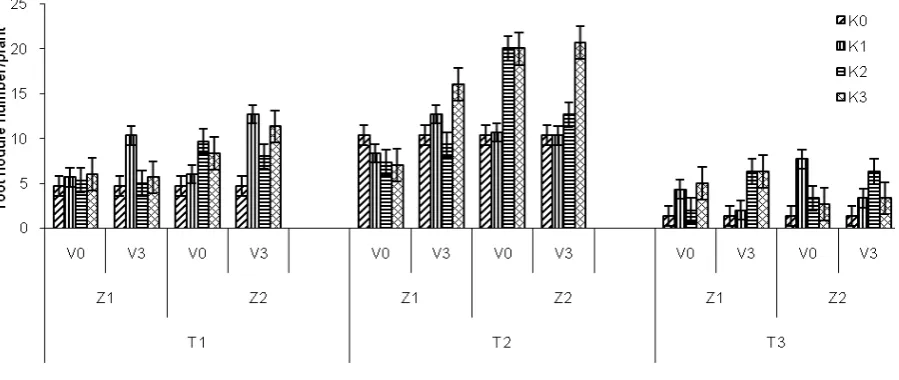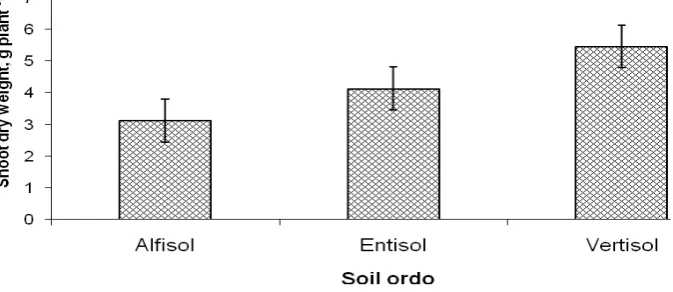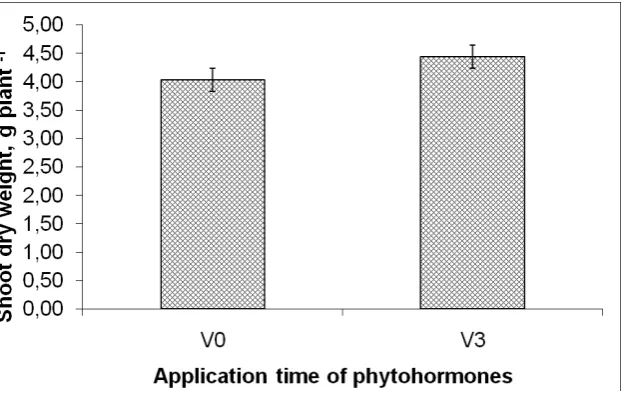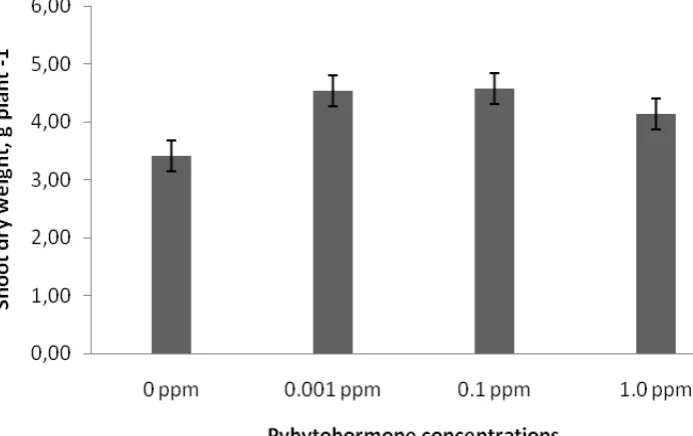http://dx.doi.org/10.17503/Agrivita-2015-37-1-p037-044
EXOGENOUS APPLICATION OF TRYPTOPHAN AND INDOLE ACETIC ACID (IAA)
TO INDUCE ROOT NODULE FORMATION AND INCREASE SOYBEAN YIELD
IN ACID, NEUTRAL AND ALKALINE SOIL
Sudadi*) and Suryono
Department of Soil Science, Faculty of Agriculture, Sebelas Maret University Jl. Ir. Sutami 36A Kentingan, Surakarta 57126
*)
Corresponding author Email: [email protected]
Received: August 25, 2014/ Accepted: January 22, 2015
ABSTRACT
The research aimed to study whether soil pH affects exogenous application of amino acid tryptophan and IAA in increasing root nodules and soybean yield. The experiment was conducted in greenhouse using 20 cm diameter plastic pot filled with fine soil, arranged in completely randomized design (CRD) with four treatments. Each treatment combination was repeated three times. Three seeds of local soybean variety were planted into each pot then to remain one plant a week after planting. Variables observed were root nodules number, shoot dry weight and seed yield. Plant nutrients were supplied in the form of solution to meet nodules, shoot and root dry weight and soybean yield. Higher root nodules number was taken from the treatment combination of 0.001 ppm IAA applied at V3 in Alfisol and Vertisols, and 1.0 ppm on Entisols. However, the highest soybean yields were taken from the treatment combination of 1.0 ppm tryptophan applied at V0 in Alfisols (6.51 g plant-1).
Keywords: alfisol, entisol, extra cellular, phyto-hormones, vertisol
INTRODUCTION
Biological nitrogen fixation is the second most important biological processes after photosynthesis. Even in natural ecosystems where there is no factory-made fertilizers and
animal waste, plant and microbial N needs are fully and dependent on the conversion of dinitrogen (N2) air by various types of prokaryotic microbes. For soybean, the existence and effectiveness of root nodules is critical (Zuberer, 1999; Elmerich and Newton., 2007; Graham, 2008; Howieson et al., 2008). Effective root nodules capable of meeting the needs of up to 75% nitrogen (Jutono, 1985; Anonymous, 1986; Ohyama et al., 2009).
According to Jutono (1985) the existence of effective root nodules should be considered in an effort to increase soybean production and reducing the use of fertilizer N. Ohyama et al.(2009) said that one of the reasons for the low yield of soybean root nodules compared to its potency is less effective but it is very difficult to create the optimum conditions for biological N2 fixation. For instance, the formation of root nodules and N2 is very sensitive to the effects of a poor environment such as drought, poor aeration, nutrient deficiencies or nutrient imbalance, soil pH (Richardson et al., 1988), as well as compatible rhizobia populations and the competitiveness to native ineffective soil rhizobia. Root nodule formation is influenced by internal factors both from plants and bacteria, such as the ability of crops to excrete tryptophan (Gray and William, 1971) and the ability of bacteria to oxidize it to IAA. In the normal process, rhizobium oxidized the amino acid tryptophan excreted by soybean plant to IAA.
response to the formation of root nodule. The indole acetic acid (IAA) is a natural auxin and one of the main growth regulators in higher plants (Prieto C et al., 2011). Plants synthetizing higher IAA showed a significant increase in shoot fresh weight and upregulation of nitrogenase gene (Bianco et al., 2014).
In the previous research, Sudadi (2011) showed that the use of extra cellular (exogenous) amino acid tryptophan and IAA increased the number of root nodules and yield of soybeans grown in sterile sand media (neutral pH). Srinivasan and Gopalkrisna cit. Mishra et acid (p-chlorophenoxy)-isobutyric acid improve root nodulation of nuts (Cartwright cit. Mishra et al., 1999). Kamal (2000) stated that epi-brasinoloid added on soybean growth media increased the number of root nodules per plant. Formation of root nodules can also be induced by other extra cellular fitohormon as cytokines (Nandwal and Bharti cit. Mishra et al., 1999) and Giberilic Acid (GA) (Bishnoi and Krishnamoorty cit. Mishra et al. 1999). This research aimed to investigate if soil pH affects the the ability of extra cellular amino acid tryptophan and IAA to enhance root nodules formation and increase soybean yield.
MATERIALS AND METHODS
The experiments were conducted from March - October 2012 in greenhouse, used 2-gallon plastic pots with Alfisol, Entisol or Vertisol soil planting medium. Soybean of local variety was used and the Rhizobium inoculant was taken from The Laboratory of Soil Microbiology and Environmental, Department of Microbiology, Faculty of Agriculture, Gadjah Mada University, Yogyakarta. The experiment was arranged in completely randomized design (CRD) factorial with four treatment factors, namely the soils ordo (T1 = Alfisol, T2 = Entisol and T3 = Vertisol), extra-cellular phytohormones (Z1 = amino acid tryptophan and Z2 = IAA), time of phytohormone apllication (V0 = at planting day and V3 = vegetative phase 3) and phytohormone concentrations (K0 = 0 ppm ; K1 = 0.001 ppm; K2 The data obtained were analyzed statistically with F test at the level confidence of 5%, followed by Duncan's multiple range test if significant.
RESULTS AND DISCUSSION
biological nitrogen fixation. Some chemical properties and texture of the soil used for the study are presented in the following table.
Table 1. Some chemical properties and texture of the soil used for research
Soil properties Alfisol Entisol Vertisol
pH (H2O) 5.60 6.80 7.80
OM content, % 1.89 3.35 1.93 Total-N, % 0.09 0.18 0.12 Available-P, ppm 3.36 42.00 35.02 Exch.-K, cmol(+) kg-1 0.27 0.29 0.30 CEC, cmol(+) kg-1 25.60 24.20 48.80 Soil texture clayed Sandy clay
loam
clayed
- sand 33 37 30 - silt 7 31 14 - clay 60 32 56
From the above table it can be said that Alfisol had fertility constraints that most of its chemical properties such as pH, organic matter content, total N, available P and K were low, whereas Alfisol had the highest fertility rate. In addition, the soil texture of Alfisol was probably better than the others.
The analysis of variance (Anova) showed that the influence of soil ordo (soil pH), and kind,
concentration and application time of phytohormones as well as their interaction on root nodules number of soybean at maximum vegetative phase were highly significant (P ≤ 0.01). The effect of those treatment factor interaction on nodule numbers was presented in Figure 1. The highest root nodules number obtained from treatment combination of K3 Z2V3T2 (1.0 ppm IAA at vegetative phase-3 in Entisol) with 20.67 nodules plant-1. According to Gosh and Basu (2002) in culture medium, Rhizobium synthesized IAA from L-tryptophan and the maximum production at 20 hr when the bacteria reached the stationary phase of growth. Nevertheless, this nodule number was neither different significantly with both nodule numbers obtained from treatment combination of K3Z2 V0 T2 (1.0 ppm IAA at planting day in Entisol) nor of treatment combination K2Z2 V0 T2 (0.1 ppm IAA at planting day in Entisol). It mean that IAA was more efficient when applied at planting day (early planting) than at vegetative-3 phase. In general, the number of root nodules in Vertisols was lower than that of Alfisols and Entisols presumably due to the physical properties of Vertisols which had hard soil structure so that plant roots were not able to penetrate it well.
Figure 1. Effect of phytohormones concentration (K), application time (V), kind of phytohormones (Z) and soil ordo (T) on soybean root nodules at maximum vegetative phase. (Note: K0 = 0 ppm; K1 = 0.001 ppm; K2 = 0.1 ppm
and K3 = 1.0 ppm; V0 = at planting date; V3 = at vegetative phase-3; Z1 = amino acid tryptophan; Z2 = IAA;
Phytohormone including auxin (IAA) plays an important role in various physiological processes during plant growth and development (Baca and Elmerich, 2007). At the cellular level, auxin affects the process of division, elongation and differentiation of cells, whereas the level of auxin affects plant tropism, the dominance of shoots, leaf senescence, sprouts morphology, leaf abscission, flowering, fruit ripening and formation and root growth (Nonhebel and Bandurski, 1984; Pandey et al., 1996; Guilfoyle et al., 1998).
In addition to plant height, plant growth can be measured by the increase of biomass dry weight, which can be expressed in terms of the dry weight of shoots and roots. From the analysis of varian, it was known that soil ordos,
as well as kinds,concentration and application time of phytohormones had very significant effect on shoot dry weight, but interaction among them had no significant effect.
According to the shoot dry weight (Figure 2), the growth of soybeans in Vertisol was the best followed by Entisols and Alfisols. This is because Vertisols had the best soil fertility as demonstrated by soil pH, cation exchange capacity and organic matter content. Generally, Vertisols is categorized in fertile soil if there is enough water and organic matter content
.
The influence of phytohormone kinds on soybean shoot dry weight is significant as shown in Figure 3.
Figure 2. The influence of soil ordos on soybean shoot dry weight
Treatment with IAA produced shoot dry weight higher than the amino acid tryptophan (Figure 3). This is because the IAA is a plant growth regulator capable of affecting the division, elongation and differentiation of cells, and it is ready to use, whereas amino acid tryptophan is needed first to oxidize IAA before it is ready to use. Bianco et al. (2014) said that plants synthetizing higher IAA will increase in higher shoot fresh weight, and Phytohormone auxin regulates plant developmental processes (Spaepen and Vanderleyden, 2010).
Existing research suggests that there are opportunities to use extra cellular phytohormones to increase root nodule formation and N2 fixation of soybean plants. For example, Srinivasan & Gopalkrisna stated that the addition of exogenous auxin or Naphtilic acetic acid (NAA) stimulate the formation and growth of Medicago sativa root nodules and Arachis hypogaea (peanut), while Cartwright stated that the addition of 1 - napthoxy acetic acid and (p-Chlorophenoxy)-isobutyric acid improves the process of root nodulation in legumes (Mishra et al. 1999). Likewise, Bishnoi and Krishnamoorty, and Nandwal an& Bhdrti stated that root nodule formation can also be induced by other phytohormones such as extra cellular cytokinin and GA (Mishra et al. 1999).
In the case of application time, phytohormones which was applied at V3 induced higher plant growth as indicated by shoot dry weight although it was not significantly different when applied at V0 (Figure 4). It was probable that
the applied amino acid tryptophan and IAA at planting day (V0) would damage more phytohormones than when applied at V3 so the increase in soybean shoots dry weight was less.
Soybean growth increased concomitantly with the increase of phytohormones concentration applied up to 0.1 ppm, then it decreased with increasing phytohormones concentration as showed Fig. 5. Bianco et al. (2014) stated that the knowledge of maximum level of IAA biosynthesis, resulting in the maximal increase of plant growth.
The influence of soils, as well as the kinds, time of application and concentration of the extra cellular amino acid tryptophan and IAA on soybean seed dry weight are presented in Figure 6.
The result showed that there were highly significant (P=0.0000) soil ordo, application time of phytohormones, and their concentrations as well as the interaction of the fourth treatments on seed dry weight. The kind of phytohormone showed no significant effect. Highest soybean grain yield was obtained from combination of treatments of 1.0 ppm amino acid tryptophan in the early planting (V0) for Alfisol soil (6.51 g plant
-1
) with an increase of 202% compared to no phytohormone (3.22 g plant-1). Figure 2 above shows that the effect of phytohormone application on soybean seed dry weight (than without phytohormone) in Alfisols was higher than that in both Entisols and Vertisols. Presumably, this is because the Alfisols was less fertile than the others. This condition made phytohormone give more positive impact to nodule formation, N2 fixation, growth and yield of soybean.
Figure 5. The influence of phytohormone concentrations on soybean shoot dry weight
CONCLUSIONS
The exogenous amino acid tryptophan and indole acetic acid (IAA) given as extra cellular growth regulators (PGR) increased the number of root nodules, shoot and seed dry weight of soybean in Alfisols, Entisols and Vertisols. Indole acetic acid (IAA) increased the number of root nodules higher than amino acid tryptophan, soo did the application time of extra cellular phytohormone at planting day (V0) which gave higher number of root nodules than when applied at V3 stage (plant have three leaves).
The treatment combination giving the highest root nodule number was K3Z2V3T2 (1.0 ppm of IAA given when the plants had three leaves in Entisols) that was 20.67 nodule plant-1. Meanwhile, the highest seed weight was obtained from the treatment combination of K3Z1V0T1 (1.0 ppm of amino acid tryptophan given at planting date in Alfisols) that was 6.51 g plant-1, which increased 202% compared with that of no phytohormone treatment. This is consistent with the results of Sudadi (2011), emphasizing that the application of 1.0 ppm of amino acid tryptophan at planting day (V0) gave the highest soybeans seed dry weight in neutral sterile sand planting media.
ACKNOWLEDGEMENTS
The author would like to thank the Head of Research and Community Services, the Directorate General of Higher Education, The Ministry of Education and Culture of Indonesia for the financial support for the research.
REFERENCES
Afza, R., G. Hardarson and F. Zapata. 1987. Effect of delayed soil and foliar N fertilization on yield and N2 fixation of soybean. Plant and Soil 97: 361 – 368. Anonymous. 1986. Legum inoculant for Soybean
(in Indonesian). (Rhizobium inoculum for soybeans). Leaflet. Laboratory of Microbiology, Fac.of. Agriculture, Gadjah Mada Univ., Yogyakarta
Baca, B. and C. Elmerich. 2007. Microbial production of plant hormones, in: C. Elmerich, W.E. Newton (Eds.), Associative and endophytic nitrogen-fixing bacteria and cyanobacterial
associations. Springer. The Netherland. p. 113-143.
Bianco, C., B. Senatore, S. Arbucci, G. Pieraccini and R. Defez. 2014. Modulation of endogenous Indole-3-acetic acid biosynthesis in bacteroids within Medicago sativa Nodules. Appl. Environ. Microbiol. 80 (14): 4286-4293.
Coyne, M.S. 1999. Soil microbiology: An exploratory approach. Chapter 22. The nitrogen cycle - nitrogen fixation. Delmar Publishers. an International Thomson Publishing company. Albany. p. 279 - 290.
Elmerich, C. and W.E. Newton. 2007. Associative and endophytic nitrogen-fixing bacteria and cyanobacterial associations. Springer, Dordrecht, The Netherlands.
Ghosh, A. and Basu, B.. 2002. Equivalent viscous damping of a liquid column damper. Proc. VETOMAC-II (Second International Conference on Vibration Engineering and Technology of Machinery). BARC. Mumbai. India. p. 104 - 105.
Graham, P. H. 2008. Chapter 2. Ecology of The Root-Nodule Bacteria of Legumes. In : Dilworth, M.J., E.K. James, J.I. Sprent and W.E. Newton., Nitrogen-fixing leguminous symbioses. Springer Science responsive transcription. Cell Mol Life Sci 54: 619–627.
Hidayat, O.O. 1985. The morphology of soybean plants.(in Indonesian). in : Somaatmadja, S., M. Ismunadji, Sumarno, M. Syams, S.O. Manurung and Yuswandi. Soybean. PPPTP. Bogor. p. 73 – 86
Howieson, J. G., R. J. Yates, K. J. Foster, D. Real, and R. B. Besier. 2008. Chapter 12. Prospects for the future use of legumes. In: Dilworth, M.J., E.K. James, J.I. Sprent and W.E. Newton., Nitrogen-fixing leguminous symbioses. Springer Science + Business Media B.V. p. 363–393. Ismunadji, M. and S.N. Mahmud. 1985. The role of
Syams, S.O. Manurung and Yuswandi. PPPTP. Bogor. p. 189 - 215.
Jutono. 1985. Rhizobium Inoculation (in Indonesian). In: Somaatmadja, S., M. Ismunadji, Sumarno, M. Syams, S.O. Manurung and Yuswandi. Soybean. PPPTP. Bogor. p. 216 – 230.
Kamal, M. 2000. Response of nodule formation, N2 fixation and sugar content in soybean nodule to epi-brassinolide application. Journal Agrista 4(2) : 120 - 126.
Keyser, H.H., P. Somasegaran and B.B. Bohlool. 1993. Rhizobial ecology and technology. In.F.B. Metting, Jr., Soil microbial ecology. Application in agricultural and environmental management. Marcel Dekker Inc. New York. p. 579 - 594. Mishra, S.N., P.K. Jaiwal, R.P. Singh and H.S.
Srivastava. 1999. Rhizobium – legume association. In: Srivastava, H.S. and R.P. Singh (edt), Nitrogen nutrition and plant growth. Science Publisher Inc. USA. p. 45 - 102.
Nonhebel H.M. and Bandurski R.S.. 1984. Oxidation of indole-3-acetic acid and oxindole-3-acetic acid to 2,3-dihydro-7-hydroxy-2-oxo-1H indole-3-acetic acid-7'-O-beta-D glucopyranoside in Zea mays seedlings. Plant Physiol 76: 979-983. Ohyama, T., N. Ohtake, K. Sueyoshi, K. Tewari,
Y. Takahashi, S. Ito, T. Nishiwaki, Y. Nagumo, S. Ishii and T. Sato. 2009. Nitrogen fixation and metabolism in soybean plants. Chapter 1. Introduction. Nova Science Publishers, Inc. New York. p. 1 - 12.
Pandey, J., D. Sinha, D. And D.P.S. Bhawuk, (Eds.). 1996. Asian contributions to cross-cultural psychology. New Delhi: Sage Publication
Pasaribu, D. and S.Suprapto S. 1985. NPK Fertili-zation on soybean. (in Indonesian) in Somaatmadja, S., M. Ismunadji, Sumarno, M. Syams, S.O. Manurung and Yuswandi. PPPTP. Bogor. p. 159 - 169. Paul, E.A. and. F.E. Clark. 1989. Soil microbiology and biochemestry. Acad. Press Inc. London. p. 164 – 197.
Prieto C., E., Cordoba C., N.M., Montenegro J., A.M. and G.E. González-Mariño,. 2011. Production of indole-3-acetic acid in the culture medium of Microalga scene-desmus obliquus (UTEX 393). J. Braz. Chem. Soc. 22 (12): 2355-2361
Richardson, A.E., M.A. Djordjevic, B.G. Rolfe and R.J. Simpson. 1988. Effect of pH, Ca, and Al on the exudation from clover seedlings of coumpouns that induce the expression of nodulation genes in Rhizobium trifolii. Plant and Soil 109: 37 – 47.
Spaepen, S. and J. Vanderleyden. 2010 Auxin and plant-microbe interactions. cold Spring Harb Perspect Biol doi: 10.1101/cshperspect.a001438 published online November 17, 2010.
Sudadi, 2011. Exogenous application of tryptophan and indole acetic acid (IAA) to induce root nodule formation and increase yield of soybean. Agricultural Science Research Journal. 2(4): 134 – 139
Widjaja-Adhi, IPG. 1985. Liming of acid soil for soybean. (in Indonesian). In: Somaatmadja, S., M. Ismunadji, Sumarno, M. Syams, S.O. Manurung and Yuswandi. PPPTP. Bogor. p. 171 - 188.



